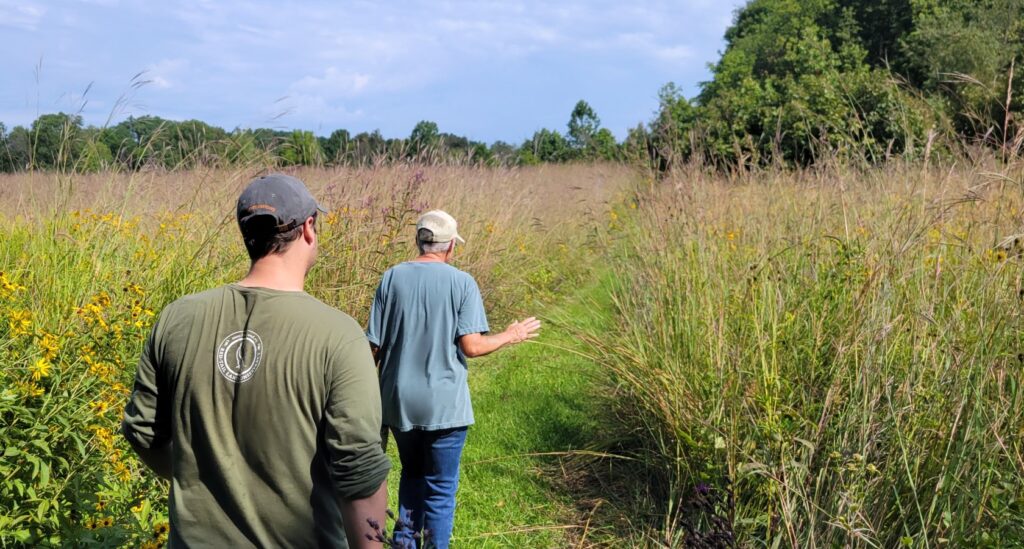
You have a connection to the land you care for and own. The land nourishes us, creates opportunities to make a living, and provides for wildlife. The land holds a special value to you and your family. But society puts a price on the land that can make landowners like you need to decide between conservation or other uses like development or production. You decide the future of your land.
Protecting your land can allow you to keep your land in a natural state while providing you with some form of financial compensation. It’s a win-win situation for you and for nature. Your course of action can leave a legacy of vital habitats for plants, wildlife, and people.
There are many different ways to preserve and protect your land. Your local trust, Red-tail Land Conservancy, are specialists that can help you find the right option for you and your land.
Click Below to Explore Conservation Options
 The Classified Forest and Wildlands Program encourages timber production, watershed protection, and wildlife habitat management on private lands in Indiana. Program landowners receive a property tax reduction in return for following a management plan. In addition to the tax incentive, landowners receive free technical assistance from DNR foresters and wildlife biologists. The minimum requirement for program enrollment is 10 acres of forest, wetland, shrubland, and/or grassland.
The Classified Forest and Wildlands Program encourages timber production, watershed protection, and wildlife habitat management on private lands in Indiana. Program landowners receive a property tax reduction in return for following a management plan. In addition to the tax incentive, landowners receive free technical assistance from DNR foresters and wildlife biologists. The minimum requirement for program enrollment is 10 acres of forest, wetland, shrubland, and/or grassland.
 EQIP is designed to promote both agricultural operations and environmental protection. The program assists landowners by providing financial and technical assistance to implement conservation practices. Using these conservation practices can mean healthier soil, cleaner air, improved water quality, and greater wildlife habitat.
EQIP is designed to promote both agricultural operations and environmental protection. The program assists landowners by providing financial and technical assistance to implement conservation practices. Using these conservation practices can mean healthier soil, cleaner air, improved water quality, and greater wildlife habitat.
 CRP is a federally funded, voluntary program that contracts with agricultural producers so that environmentally sensitive agricultural land is used for conservation benefits, such as wetlands and grasslands. FSA provides participants with rental payments and cost-share assistance to plant grasses or trees to improve soil health, prevent erosion, and enrich wildlife habitat. Contract duration is approximately 15 years.
CRP is a federally funded, voluntary program that contracts with agricultural producers so that environmentally sensitive agricultural land is used for conservation benefits, such as wetlands and grasslands. FSA provides participants with rental payments and cost-share assistance to plant grasses or trees to improve soil health, prevent erosion, and enrich wildlife habitat. Contract duration is approximately 15 years.
![]() WRP is a voluntary program offering landowners technical and financial support to protect, restore, and enhance wetlands on their property. The NRCS goal is to achieve the greatest wetland functions and values, along with optimum wildlife habitat, on every acre enrolled in the program. Depending on the level of funding received, landowners may choose a permanent or 30-year conservation easement or a cost-share agreement where no easement is involved.
WRP is a voluntary program offering landowners technical and financial support to protect, restore, and enhance wetlands on their property. The NRCS goal is to achieve the greatest wetland functions and values, along with optimum wildlife habitat, on every acre enrolled in the program. Depending on the level of funding received, landowners may choose a permanent or 30-year conservation easement or a cost-share agreement where no easement is involved.
 A CE is a voluntary legal agreement that landowners can use to permanently preserve wildlife habitat, natural areas, and agricultural land. Each easement is unique and reflects the landowner’s vision for his or her land, while protecting the land’s conservation values forever. Future owners must abide by the terms of the conservation easement. Red-tail regularly monitors land under easement to be sure its natural values are protected now and in the future.
A CE is a voluntary legal agreement that landowners can use to permanently preserve wildlife habitat, natural areas, and agricultural land. Each easement is unique and reflects the landowner’s vision for his or her land, while protecting the land’s conservation values forever. Future owners must abide by the terms of the conservation easement. Red-tail regularly monitors land under easement to be sure its natural values are protected now and in the future.
 A landowner may choose to relinquish ownership of the land, especially when their children or heirs have no interest in caring for the land. Land trusts can accept partial or full donations of land which they will then steward and protect forever. Limited funds may be available to purchase land, or property can be given as a bequest following the owner’s death. Full and partial donations of land can provide tax benefits to the landowner.
A landowner may choose to relinquish ownership of the land, especially when their children or heirs have no interest in caring for the land. Land trusts can accept partial or full donations of land which they will then steward and protect forever. Limited funds may be available to purchase land, or property can be given as a bequest following the owner’s death. Full and partial donations of land can provide tax benefits to the landowner.
Ready to Talk?
Complete this form to start a conversation with a Red-tail Land Conservancy staff member about conserving your land.
